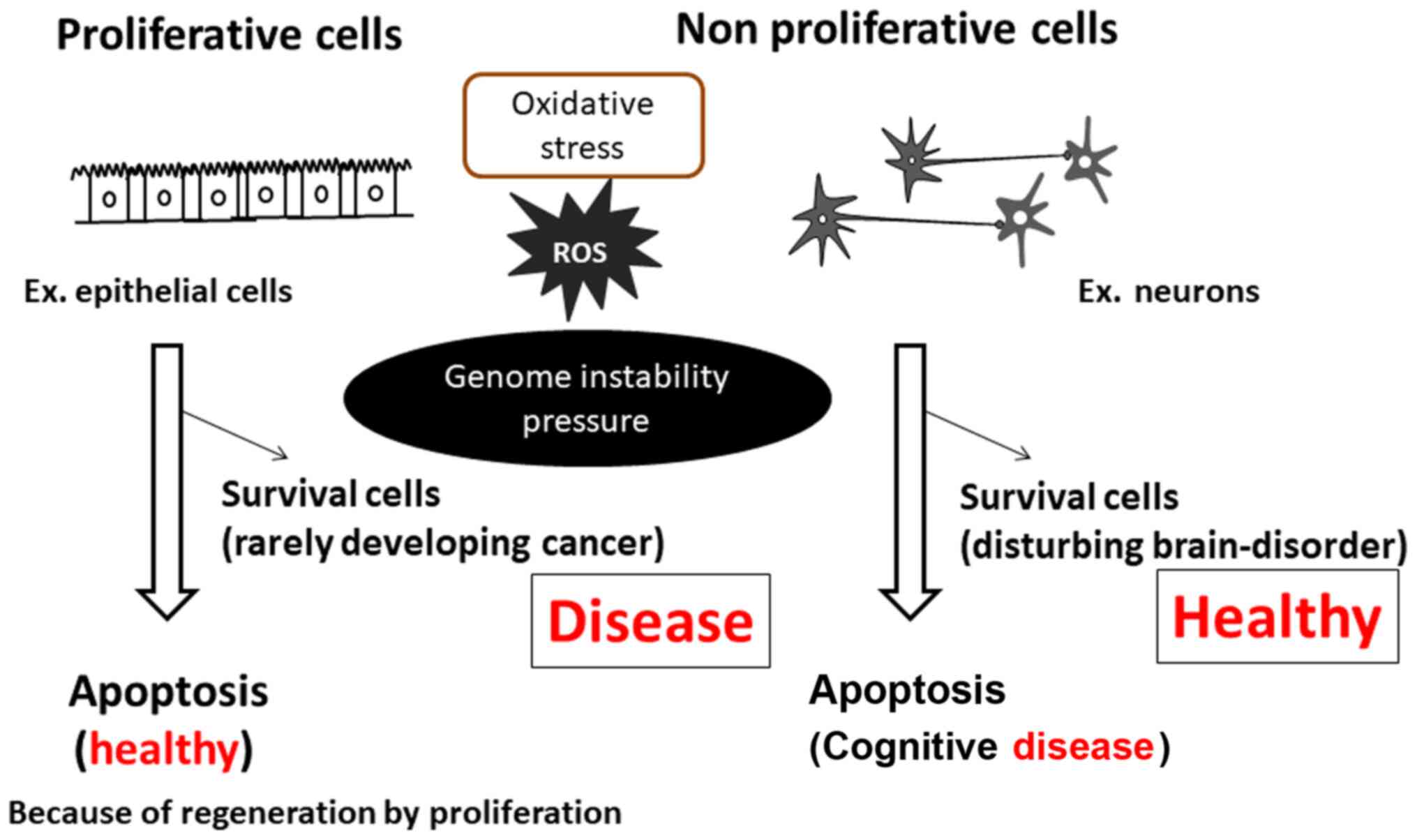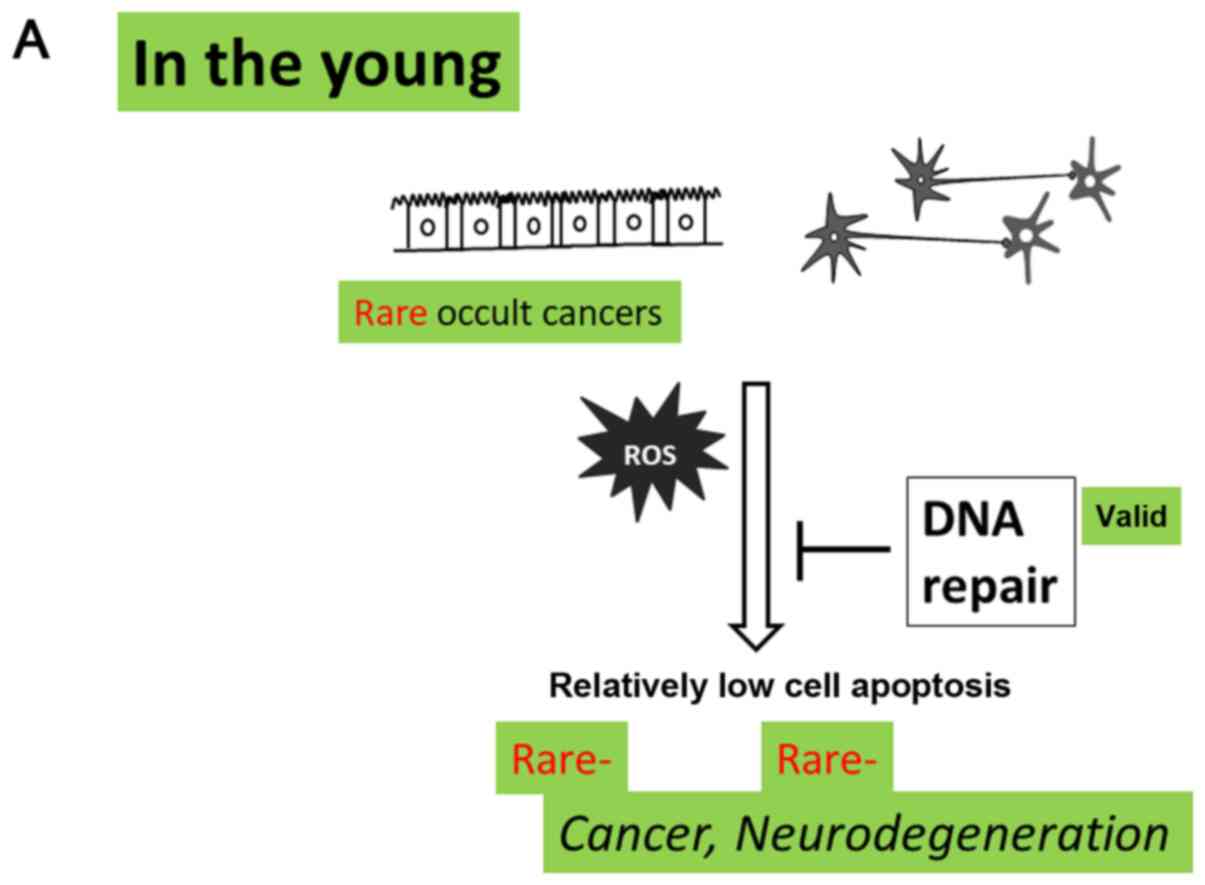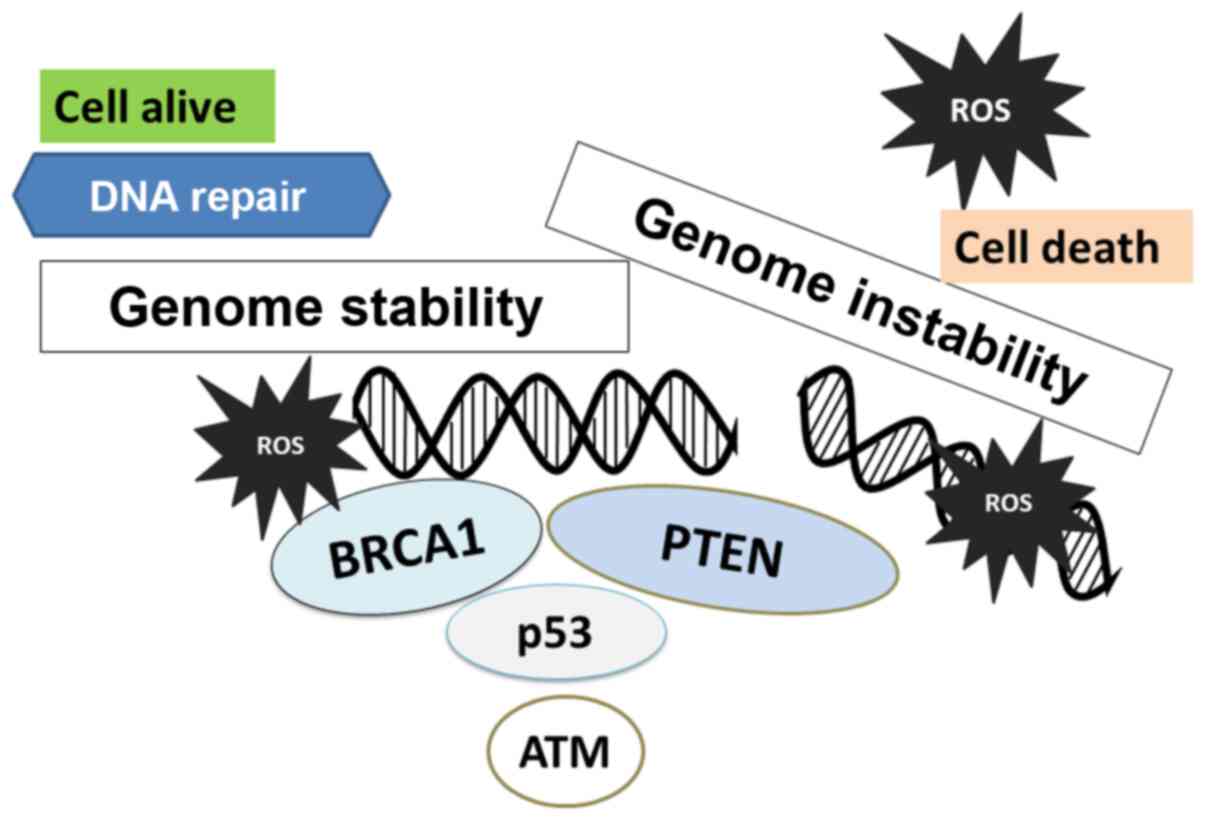|
1
|
Awasthi P, Foiani M and Kumar A: ATM and
ATR signaling at a glance. J Cell Sci. 128:4255–4262.
2015.PubMed/NCBI View Article : Google Scholar
|
|
2
|
Van Haaften G, Plasterk RH and Tijsterman
M: Genomic instability and cancer: Scanning the Caenorhabditis
elegans genome for tumor suppressors. Oncogene. 23:8366–8375.
2004.PubMed/NCBI View Article : Google Scholar
|
|
3
|
Ghezzi EM and Ship JA: Systemic diseases
and their treatments in the elderly: Impact on oral health. J
Public Health Dent. 60:289–296. 2000.PubMed/NCBI View Article : Google Scholar
|
|
4
|
Zhang Q, Guo S, Zhang X, Tang S, Shao W,
Han X, Wang L and Du Y: Inverse relationship between cancer and
Alzheimer's disease: A systemic review meta-analysis. Neurol Sci.
36:1987–1994. 2015.PubMed/NCBI View Article : Google Scholar
|
|
5
|
Musicco M, Adorni F, Di Santo S, Prinelli
F, Pettenati C, Caltagirone C, Palmer K and Russo A: Inverse
occurrence of cancer and Alzheimer disease: A population-based
incidence study. Neurology. 81:322–328. 2013.PubMed/NCBI View Article : Google Scholar
|
|
6
|
Nudelman KN, Risacher SL, West JD,
McDonald BC, Gao S and Saykin AJ: Alzheimer's disease neuroimaging
initiative. Association of cancer history with Alzheimer's disease
onset and structural brain changes. Front Physiol.
5(423)2014.PubMed/NCBI View Article : Google Scholar
|
|
7
|
Liu Y, Chen Q and Zhang JT: Tumor
suppressor gene 14-3-3sigma is down-regulated whereas the
proto-oncogene translation elongation factor 1delta is up-regulated
in non-small cell lung cancers as identified by proteomic
profiling. J Proteome Res. 3:728–735. 2004.PubMed/NCBI View Article : Google Scholar
|
|
8
|
Boiko AD, Porteous S, Razorenova OV,
Krivokrysenko VI, Williams BR and Gudkov AV: A systematic search
for downstream mediators of tumor suppressor function of p53
reveals a major role of BTG2 in suppression of Ras-induced
transformation. Genes Dev. 20:236–252. 2006.PubMed/NCBI View Article : Google Scholar
|
|
9
|
Payne CM, Bernstein C, Dvorak K and
Bernstein H: Hydrophobic bile acids, genomic instability, Darwinian
selection, and colon carcinogenesis. Clin Exp Gastroenterol.
1:19–47. 2008.PubMed/NCBI View Article : Google Scholar
|
|
10
|
Fujikake N, Shin M and Shimizu S:
Association between autophagy and neurodegenerative diseases. Front
Neurosci. 12(255)2018.PubMed/NCBI View Article : Google Scholar
|
|
11
|
Madabhushi R, Pan L and Tsai LH: DNA
damage and its links to neurodegeneration. Neuron. 83:266–282.
2014.PubMed/NCBI View Article : Google Scholar
|
|
12
|
Bradley-Whitman MA, Timmons MD, Beckett
TL, Murphy MP, Lynn BC and Lovell MA: Nucleic acid oxidation: An
early feature of Alzheimer's disease. J Neurochem. 128:294–304.
2014.PubMed/NCBI View Article : Google Scholar
|
|
13
|
Canugovi C, Shamanna RA, Croteau DL and
Bohr VA: Base excision DNA repair levels in mitochondrial lysates
of Alzheimer's disease. Neurobiol Aging. 35:1293–1300.
2014.PubMed/NCBI View Article : Google Scholar
|
|
14
|
Chen W, Zou P, Zhao Z, Chen X, Fan X,
Vinothkumar R, Cui R, Wu F, Zhang Q, Liang G and Ji J: Synergistic
antitumor activity of rapamycin and EF24 via increasing ROS for the
treatment of gastric cancer. Redox Biol. 10:78–89. 2016.PubMed/NCBI View Article : Google Scholar
|
|
15
|
Zhao L, Wang JL, Wang YR and Fa XZ:
Apigenin attenuates copper-mediated β-amyloid neurotoxicity through
antioxidation, mitochondrion protection and MAPK signal
inactivation in an AD cell model. Brain Res. 1492:33–45.
2013.PubMed/NCBI View Article : Google Scholar
|
|
16
|
Wang Y, Branicky R, Noë A and Hekimi S:
Superoxide dismutases: Dual roles in controlling ROS damage and
regulating ROS signaling. J Cell Biol. 217:1915–1928.
2018.PubMed/NCBI View Article : Google Scholar
|
|
17
|
Pong K: Oxidative stress in
neurodegenerative diseases: Therapeutic implications for superoxide
dismutase mimetics. Expert Opin Biol Ther. 3:127–139.
2003.PubMed/NCBI View Article : Google Scholar
|
|
18
|
Nazıroğlu M, Muhamad S and Pecze L:
Nanoparticles as potential clinical therapeutic agents in
Alzheimer's disease: Focus on selenium nanoparticles. Expert Rev
Clin Pharmacol. 10:773–782. 2017.PubMed/NCBI View Article : Google Scholar
|
|
19
|
Cudkowicz ME, Pastusza KA, Sapp PC,
Mathews RK, Leahy J, Pasinelli P, Francis JW, Jiang D, Andersen JK
and Brown RH Jr: Survival in transgenic ALS mice does not vary with
CNS glutathione peroxidase activity. Neurology. 59:729–734.
2002.PubMed/NCBI View Article : Google Scholar
|
|
20
|
Sangwan S and Eisenberg DS: Perspective on
SOD1 mediated toxicity in Amyotrophic Lateral Sclerosis. Postepy
Biochem. 62:362–369. 2016.PubMed/NCBI
|
|
21
|
Kostrominova TY: Advanced age-related
denervation and fiber-type grouping in skeletal muscle of SOD1
knockout mice. Free Radic Biol Med. 49:1582–1593. 2010.PubMed/NCBI View Article : Google Scholar
|
|
22
|
Kang SW: Superoxide dismutase 2 gene and
cancer risk: Evidence from an updated meta-analysis. Int J Clin Exp
Med. 8:14647–14655. 2015.PubMed/NCBI
|
|
23
|
Flynn JM and Melov S: SOD2 in
mitochondrial dysfunction and neurodegeneration. Free Radic Biol
Med. 62:4–12. 2013.PubMed/NCBI View Article : Google Scholar
|
|
24
|
Hroudová J, Singh N and Fišar Z:
Mitochondrial dysfunctions in neurodegenerative diseases: Relevance
to Alzheimer's disease. Biomed Res Int. 2014(175062)2014.PubMed/NCBI View Article : Google Scholar
|
|
25
|
Hinerfeld D, Traini MD, Weinberger RP,
Cochran B, Doctrow SR, Harry J and Melov S: Endogenous
mitochondrial oxidative stress: Neurodegeneration, proteomic
analysis, specific respiratory chain defects, and efficacious
antioxidant therapy in superoxide dismutase 2 null mice. J
Neurochem. 88:657–667. 2004.PubMed/NCBI View Article : Google Scholar
|
|
26
|
Papa L, Hahn M, Marsh EL, Evans BS and
Germain D: SOD2 to SOD1 switch in breast cancer. Biol Chem.
289:5412–5416. 2014.PubMed/NCBI View Article : Google Scholar
|
|
27
|
Teoh-Fitzgerald ML, Fitzgerald MP, Jensen
TJ, Futscher BW and Domann FE: Genetic and epigenetic inactivation
of extracellular superoxide dismutase promotes an invasive
phenotype in human lung cancer by disrupting ECM homeostasis. Mol
Cancer Res. 10:40–51. 2012.PubMed/NCBI View Article : Google Scholar
|
|
28
|
Baluchnejadmojarad T, Mansouri M, Ghalami
J, Mokhtari Z and Roghani M: Sesamin imparts neuroprotection
against intrastriatal 6-hydroxydopamine toxicity by inhibition of
astroglial activation, apoptosis, and oxidative stress. Biomed
Pharmacother. 88:754–761. 2017.PubMed/NCBI View Article : Google Scholar
|
|
29
|
Petro M, Jaffer H, Yang J, Kabu S, Morris
VB and Labhasetwar V: Tissue plasminogen activator followed by
antioxidant-loaded nanoparticle delivery promotes
activation/mobilization of progenitor cells in infarcted rat brain.
Biomaterials. 81:169–180. 2016.PubMed/NCBI View Article : Google Scholar
|
|
30
|
Dilawari A, Cangiarella J, Smith J, Huang
A, Downey A and Muggia F: Co-existence of breast and ovarian
cancers in BRCA germ-line mutation carriers. Ecancermedicalscience.
2(109)2008.PubMed/NCBI View Article : Google Scholar
|
|
31
|
Modena A, Iacovelli R, Scarpa A, Brunelli
M, Ciccarese C, Fantinel E, Bimbatti D, Massari F, Martignoni G and
Tortora G: Investigating BRCA mutations: A breakthrough in
precision medicine of castration-resistant prostate cancer. Target
Oncol. 11:569–577. 2016.PubMed/NCBI View Article : Google Scholar
|
|
32
|
Guirouilh-Barbat JK, Wilhelm T and Lopez
BS: AKT1/BRCA1 in the control of homologous recombination and
genetic stability: The missing link between hereditary and sporadic
breast cancers. Oncotarget. 1:691–699. 2010.PubMed/NCBI View Article : Google Scholar
|
|
33
|
Ogino M, Ichimura M, Nakano N, Minami A,
Kitagishi Y and Matsuda S: Roles of PTEN with DNA repair in
Parkinson's disease. Int J Mol Sci. 17(954)2016.PubMed/NCBI View Article : Google Scholar
|
|
34
|
Gonzalez ME, Li X, Toy K, DuPrie M,
Ventura AC, Banerjee M, Ljungman M, Merajver SD and Kleer CG:
Downregulation of EZH2 decreases growth of estrogen
receptor-negative invasive breast carcinoma and requires BRCA1.
Oncogene. 28:843–853. 2009.PubMed/NCBI View Article : Google Scholar
|
|
35
|
Suberbielle E, Djukic B, Evans M, Kim DH,
Taneja P, Wang X, Finucane M, Knox J, Ho K, Devidze N, et al: DNA
repair factor BRCA1 depletion occurs in Alzheimer brains and
impairs cognitive function in mice. Nat Commun.
6(8897)2015.PubMed/NCBI View Article : Google Scholar
|
|
36
|
Brown EJ: Analysis of cell cycle
progression and genomic integrity in early lethal knockouts.
Methods Mol Biol. 280:201–212. 2004.PubMed/NCBI View Article : Google Scholar
|
|
37
|
Jacobsen E, Beach T, Shen Y, Li R and
Chang Y: Deficiency of the Mre11 DNA repair complex in Alzheimer's
disease brains. Brain Res Mol Brain Res. 128:1–7. 2004.PubMed/NCBI View Article : Google Scholar
|
|
38
|
Jhanwar-Uniyal M: BRCA1 in cancer, cell
cycle and genomic stability. Front Biosci. 8 (Suppl):S1107–S1117.
2003.PubMed/NCBI View
Article : Google Scholar
|
|
39
|
Hradek AC, Lee HP, Siedlak SL, Torres SL,
Jung W, Han AH and Lee HG: Distinct chronology of neuronal cell
cycle re-entry and tau pathology in the 3xTg-AD mouse model and
Alzheimer's disease patients. J Alzheimers Dis. 4:57–65.
2015.PubMed/NCBI View Article : Google Scholar
|
|
40
|
Padmanabhan J, Brown K and Shelanski ML:
Cell cycle inhibition and retinoblastoma protein overexpression
prevent Purkinje cell death in organotypic slice cultures. Dev
Neurobiol. 67:818–826. 2007.PubMed/NCBI View Article : Google Scholar
|
|
41
|
Delobel P, Lavenir I, Ghetti B, Holzer M
and Goedert M: Cell-cycle markers in a transgenic mouse model of
human tauopathy: Increased levels of cyclin-dependent kinase
inhibitors p21Cip1 and p27Kip1. Am J Pathol. 168:878–887.
2006.PubMed/NCBI View Article : Google Scholar
|
|
42
|
Bialopiotrowicz E, Szybinska A, Kuzniewska
B, Buizza L, Uberti D, Kuznicki J and Wojda U: Highly pathogenic
Alzheimer's disease presenilin 1 P117R mutation causes a specific
increase in p53 and p21 protein levels and cell cycle dysregulation
in human lymphocytes. J Alzheimers Dis. 32:397–415. 2012.PubMed/NCBI View Article : Google Scholar
|
|
43
|
Yin Y and Shen WH: PTEN: A new guardian of
the genome. Oncogene. 27:5443–5453. 2008.PubMed/NCBI View Article : Google Scholar
|
|
44
|
Wise HM, Hermida MA and Leslie NR:
Prostate cancer, PI3K, PTEN and prognosis. Clin Sci (Lond).
131:197–210. 2017.PubMed/NCBI View Article : Google Scholar
|
|
45
|
Yakubov E, Ghoochani A, Buslei R,
Buchfelder M, Eyüpoglu IY and Savaskan N: Hidden association of
Cowden syndrome, PTEN mutation and meningioma frequency.
Oncoscience. 3:149–155. 2016.PubMed/NCBI View Article : Google Scholar
|
|
46
|
Hou SQ, Ouyang M, Brandmaier A, Hao H and
Shen WH: PTEN in the maintenance of genome integrity: From DNA
replication to chromosome segregation. Bioessays:.
39(1700082)2017.PubMed/NCBI View Article : Google Scholar
|
|
47
|
Ming M and He YY: PTEN in DNA damage
repair. Cancer Lett. 319:125–129. 2012.PubMed/NCBI View Article : Google Scholar
|
|
48
|
Fiandalo MV and Kyprianou N: Caspase
control: Protagonists of cancer cell apoptosis. Exp Oncol.
34:165–175. 2012.PubMed/NCBI
|
|
49
|
Krishnan A and Zochodne DW: Is cytoplasmic
PTEN a specific target for neuronal survival? Mol Neurobiol.
52:1758–1764. 2015.PubMed/NCBI View Article : Google Scholar
|
|
50
|
Asua D, Bougamra G, Calleja-Felipe M,
Morales M and Knafo S: Peptides acting as cognitive enhancers.
Neuroscience. 370:81–87. 2018.PubMed/NCBI View Article : Google Scholar
|
|
51
|
Frere S and Slutsky I: Targeting PTEN
interactions for Alzheimer's disease. Nat Neurosci. 19:416–418.
2016.PubMed/NCBI View Article : Google Scholar
|
|
52
|
Knafo S, Sánchez-Puelles C, Palomer E,
Delgado I, Draffin JE, Mingo J, Wahle T, Kaleka K, Mou L,
Pereda-Perez I, et al: PTEN recruitment controls synaptic and
cognitive function in Alzheimer's models. Nat Neurosci. 19:443–453.
2016.PubMed/NCBI View Article : Google Scholar
|
|
53
|
Zhang YY, Huang J, Yang M, Gu LJ, Ji JY,
Wang LJ and Yuan WJ: Effect of a low-protein diet supplemented with
Keto-acids on autophagy and inflammation in 5/6 nephrectomized
rats. Biosci Rep. 35(e00263)2015.PubMed/NCBI View Article : Google Scholar
|
|
54
|
Estevez AO, Morgan KL, Szewczyk NJ, Gems D
and Estevez M: The neurodegenerative effects of selenium are
inhibited by FOXO and PINK1/PTEN regulation of insulin/insulin-like
growth factor signaling in Caenorhabditis elegans. Neurotoxicology.
41:28–43. 2014.PubMed/NCBI View Article : Google Scholar
|
|
55
|
Machado-Silva A, Perrier S and Bourdon JC:
p53 family members in cancer diagnosis and treatment. Semin Cancer
Biol. 20:57–62. 2010.PubMed/NCBI View Article : Google Scholar
|
|
56
|
Stewart-Ornstein J and Lahav G: p53
dynamics in response to DNA damage vary across cell lines and are
shaped by efficiency of DNA repair and activity of the kinase ATM.
Sci Signal. 10(eaah6671)2017.PubMed/NCBI View Article : Google Scholar
|
|
57
|
Zhang XP, Liu F, Cheng Z and Wang W: Cell
fate decision mediated by p53 pulses. Version 2. Proc Natl Acad Sci
USA. 106:12245–50. 2009.PubMed/NCBI View Article : Google Scholar
|
|
58
|
Bénard J, Douc-Rasy S and Ahomadegbe JC:
TP53 family members and human cancers. Hum Mutat. 21:182–191.
2003.PubMed/NCBI View Article : Google Scholar
|
|
59
|
Varley JM: Germline TP53 mutations and
Li-Fraumeni syndrome. Hum Mutat. 21:313–320. 2003.PubMed/NCBI View Article : Google Scholar
|
|
60
|
Zhao J, Lammers P, Torrance CJ and Bader
AG: TP53-independent function of miR-34a via HDAC1 and
p21(CIP1/WAF1.). Mol Ther. 21:1678–1686. 2013.PubMed/NCBI View Article : Google Scholar
|
|
61
|
O'Neil N and Rose A: DNA repair. WormBook.
Jan, 13:1–12. 2006.PubMed/NCBI View Article : Google Scholar
|
|
62
|
Golubnitschaja O: Cell cycle checkpoints:
The role and evaluation for early diagnosis of senescence,
cardiovascular, cancer, and neurodegenerative diseases. Amino
Acids. 32:359–371. 2007.PubMed/NCBI View Article : Google Scholar
|
|
63
|
Hazan I, Hofmann TG and Aqeilan RI: Tumor
suppressor genes within common fragile sites are active players in
the DNA damage response. PLoS Genet. 12(e1006436)2016.PubMed/NCBI View Article : Google Scholar
|
|
64
|
Thurn KT, Thomas S, Raha P, Qureshi I and
Munster PN: Histone deacetylase regulation of ATM-mediated DNA
damage signaling. Mol Cancer Ther. 12:2078–2087. 2013.PubMed/NCBI View Article : Google Scholar
|
|
65
|
Le Corre L, Fustier P, Chalabi N, Bignon
YJ and Bernard-Gallon D: Effects of resveratrol on the expression
of a panel of genes interacting with the BRCA1 oncosuppressor in
human breast cell lines. Clin Chim Acta. 344:115–121.
2004.PubMed/NCBI View Article : Google Scholar
|
|
66
|
Matsuda S, Nakagawa Y, Kitagishi Y,
Nakanishi A and Murai T: Reactive oxygen species, superoxide
dimutases, and PTEN-p53-AKT-MDM2 signaling loop network in
mesenchymal Stem/Stromal cells regulation. Cells.
7(36)2018.PubMed/NCBI View Article : Google Scholar
|
|
67
|
Hair JM, Terzoudi GI, Hatzi VI, Lehockey
KA, Srivastava D, Wang W, Pantelias GE and Georgakilas AG: BRCA1
role in the mitigation of radiotoxicity and chromosomal instability
through repair of clustered DNA lesions. Chem Biol Interact.
188:350–358. 2010.PubMed/NCBI View Article : Google Scholar
|
|
68
|
Liu W, Zhou Y, Reske SN and Shen C: PTEN
mutation: Many birds with one stone in tumorigenesis. Anticancer
Res. 28:3613–3619. 2008.PubMed/NCBI
|
|
69
|
Kobayashi H, Ogawa K, Kawahara N, Iwai K,
Niiro E, Morioka S and Yamada Y: Sequential molecular changes and
dynamic oxidative stress in high-grade serous ovarian
carcinogenesis. Free Radic Res. 51:755–764. 2017.PubMed/NCBI View Article : Google Scholar
|
|
70
|
Bankoglu EE, Tschopp O, Schmitt J, Burkard
P, Jahn D, Geier A and Stopper H: Role of PTEN in oxidative stress
and DNA damage in the liver of whole-body Pten Haplodeficient mice.
PLoS One. 11(e0166956)2016.PubMed/NCBI View Article : Google Scholar
|
|
71
|
Armstrong CW, Maxwell PJ, Ong CW, Redmond
KM, McCann C, Neisen J, Ward GA, Chessari G, Johnson C, Crawford
NT, et al: PTEN deficiency promotes macrophage infiltration and
hypersensitivity of prostate cancer to IAP antagonist/radiation
combination therapy. Oncotarget. 7:7885–7898. 2016.PubMed/NCBI View Article : Google Scholar
|
|
72
|
Zhang R, Zhu L, Zhang L, Xu A, Li Z, Xu Y,
He P, Wu M, Wei F and Wang C: PTEN enhances G2/M arrest in
Etoposide-treated MCF-7 cells through activation of the ATM
pathway. Oncol Rep. 35:2707–2714. 2016.PubMed/NCBI View Article : Google Scholar
|
|
73
|
Yin H, Zhou Y, Wen C, Zhou C, Zhang W, Hu
X, Wang L, You C and Shao J: Curcumin sensitizes glioblastoma to
temozolomide by simultaneously generating ROS and disrupting
AKT/mTOR signaling. Oncol Rep. 32:1610–1616. 2014.PubMed/NCBI View Article : Google Scholar
|

















